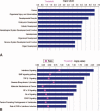MicroRNA Expression Profile Reveals miR-17-92 and miR-143-145 Cluster in Synchronous Colorectal Cancer
- PMID: 26266366
- PMCID: PMC4616700
- DOI: 10.1097/MD.0000000000001297
MicroRNA Expression Profile Reveals miR-17-92 and miR-143-145 Cluster in Synchronous Colorectal Cancer
Abstract
The expression of abnormal microRNA (miRNA, miR) is a ubiquitous feature of colorectal cancer (CRC). The pathological features and clinical behaviors of synchronous CRC have been comprehensively described; however, the expression profile of miRNA and small nucleolar RNA (snoRNA) in synchronous CRC has not been elucidated. In the present study, the expression profile of miRNA and snoRNA in 5 synchronous CRCs, along with the matched normal colorectal tissue was evaluated by microarray. Function and pathway analyses of putative targets, predicted from miRNA-mRNA interaction, were performed. Moreover, we analyzed clinicopathological and molecular characteristics of 22 patients with synchronous CRC and 579 solitary CRCs in a retrospective cohort study. We found a global dysregulation of miRNAs, including an oncogenic miR-17-92 cluster and oncosuppressive miR-143-145 cluster, and snoRNAs in synchronous CRC. Differential miRNA rather than snoRNA expression was robust enough to distinguish synchronous cancer from normal mucosa. Function analysis of putative targets suggested that miRNA clusters may modulate multiple effectors of oncogenic pathways involved in the pathogenesis of synchronous CRC. A comparison of normal mucosa between synchronous and solitary CRC suggested a differential genetic background of synchronous CRC from solitary CRC during carcinogenesis. Compared with solitary cancer patients, synchronous cases exhibited multiple extra-colonic cancers (P = 0.012), coexistence of adenoma (P = 0.012), microsatellite instability (P = 0.024), and less glucose transporter 1 (P = 0.037). Aberrant miRNA expression profiles could potentially be used as a diagnostic tool for synchronous CRC. Our findings represent the first comprehensive miRNA and snoRNA expression signatures for synchronous CRC, implicating that the miRNAs and snoRNAs may present therapeutic targets for synchronous CRC.
Conflict of interest statement
The authors have no conflicts of interest to disclose.
Figures





References
-
- Latournerie M, Jooste V, Cottet V, et al. Epidemiology and prognosis of synchronous colorectal cancers. Br J Surg 2008; 95:1528–1533. - PubMed
Publication types
MeSH terms
Substances
LinkOut - more resources
Full Text Sources
Medical
Molecular Biology Databases

